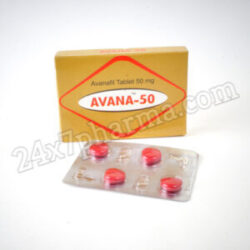Avanafil
Showing all 4 resultsSorted by latest
Avanafil (Stendra): Your Ally in the Journey to Better Sexual Health
Imagine the frustration and disappointment of struggling with erectile dysfunction (ED). For many men, this challenge impacts more than just physical performance; it affects self-esteem and relationships. But there’s hope on the horizon.
Avanafil, commonly known as Stendra, is a leading medication for erectile dysfunction. When taken as directed by a healthcare provider, this ED solution can significantly enhance sexual performance by helping achieve and maintain a firm erection. The benefits of prompt treatment extend beyond physical health—restoring confidence and reigniting intimacy in your relationship.
In a sea of online pharmacies, finding a reliable and affordable source can be overwhelming. At 24×7 Pharma, we stand out as a cheap online pharmacy committed to providing exceptional value.
Serving Customers in the USA, Canada, Australia, and Beyond
No matter where you are—in the USA, Canada, Australia, or other countries—we are dedicated to meeting your needs. Don’t let erectile dysfunction dictate your life. Visit our website to buy avanafil online (Stendra) and experience the advantages of choosing 24×7 Pharma. With our unbeatable offers and commitment to quality, you’re just a click away from reclaiming your confidence and enhancing your intimacy.
Avanafil (Stendra) Uses:
Impotence or erectile dysfunction, or ED, is a condition that male sexual function issues are treated with Avanafil. When combined with sexual stimulation, avanafil online helps a man get and maintain an erection by boosting blood flow to the penis.
Working of Avanafil (Stendra):
One essential component that expands the penile blood vessels is avanafil generic. This impotence medication works by improving blood flow to the entire genital area. This medication blocks PDE5 enzymes by clogging them. The strong medication smoothes the tissues and muscles of the penile area. Blood flow into the penile area is facilitated by the smooth tissues and muscles of the penile area. The penis grows erect when it receives enough blood flow to the sexual organ.
Dosage of Avanafil (Generic Stendra)
Patients with EDs should take the maintenance dose, which is 50 mg. Avanafil dosage is prescribed at 100 mg. The first dose should be taken by men 30 minutes prior to engaging in sexual activity. Patients with ED should take the maximum amount of 200 mg an hour before making love. Following an evaluation of their condition, ED patients are provided the exact dosage.
How to Take this Medication?
As prescribed by your physician, take this medication orally, either with or without meals, typically as needed. There are several doses of this drug available. Avanafil generic should be taken either 15 or 30 minutes prior to sexual activity, depending on your dosage. Pay close attention to your doctor’s recommendations regarding the optimal time to take this medicine prior to engaging in sexual activities. Take no more than once each day.
Side Effects
Common side effects of this medication include headache, flushing, and dizziness. If these symptoms persist or worsen, it is important to inform your healthcare provider or pharmacist as soon as possible.
Warnings & Precautions
Avanafil generic is a medication for erectile dysfunction, but it comes with important precautions and warnings. These include the risk of sudden blood pressure decrease, making it unsuitable for patients who recently had a heart attack or stroke. Priapism, a prolonged erection, requires immediate medical attention. Sudden vision or hearing loss also requires discontinuation and medical help. The medicine should not be taken with nitrates or guanylate cyclase stimulators due to dangerous blood pressure drops. Following these precautions is crucial for the safe use of medication.
Drug Interactions
Drug should not be used with nitrates or guanylate cyclase stimulators, as this can cause a drop in blood pressure.
Substitute
Vardenafil, Sildenafil, and Tadalafil are Avanafil substitutes. They’re all Viagra medications meant to address erectile dysfunction. Depending on how severe a man’s impotence is, a medical professional may prescribe an impotence medicine.
Storage
This drug should be kept out of the heat, moisture, and sunlight in a closed, room temperature container.
Avanafil Price
The Avanafil price, sold under the brand name Stendra, can be over $50 per pill, even with insurance. You can buy Avanafil online or at any authorized pharmacy.
FAQs
What precautions should I take before using Avanafil (stendra)?
Before taking medicine, inform your doctor about any allergies, especially to Avanafil or any other medications. If you are taking a nitrate medication for heart issues or chest pain, do not use Avanafil.
What should I do if I experience a prolonged erection or other serious side effects?
If an erection lasts longer than 4 hours or if you experience sudden vision loss, sudden hearing loss, or other serious side effects, seek immediate medical attention.
How often can avanafil (stendra) be taken?
The recommended dose 100 milligrams (mg) as a single dose, taken 15 minutes before sexual activity. Depending on the individual’s response to the medication, the dose may be adjusted by the doctor.




